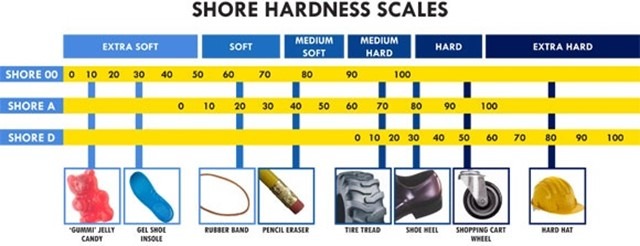When fielding questions about seal design and utilization the customer is often asked if they know the hardness of the rubber or lip material. It is important to know the hardness of the rubber material, as the hardness does have an impact on seal performance. Hardness is defined as resistance to indentation. The degree of measurement of this hardness can also be referred to as its durometer. These terms are sometimes used interchangeably in the industry. The hardness of a rubber can be modified by compounding and/or vulcanization during the production process. Generally, the more the rubber is modified the harder it becomes. Before discussing hardness and how it relates to seal performance, there are two primary methods of performing hardness tests that are used in the rubber industry.

The Shore Durometer scale was defined by Albert Shore in the 1920’s, and is the most common method of hardness measurement used in the USA. Abroad, most hardness readings use the International Rubber Hardness Degree (IRHD.) Fortunately, these hardness tests use the same scales when conducting measurements. When conducting hardness or durometer measurements, there are many variables that could influence these readings on the scale: the rate at which the probe is applied to the rubber sample; the amount of force used; the time between the probe hitting the rubber and the recording; and the temperature of both the environment and the rubber sample. Because this is an imprecise method of measuring hardness it is usually recommended that several tests be taken and that an average is used to determine the hardness. Because of this range of readings, these tests are often provided with a tolerance of +/- 5 points. ASTM D2240 offers a wide range of scales(12) to be used when measuring the hardness of elastomers, rubbers, or plastics. Generally, for softer rubber products we use a Shore A scale and for harder rubbers a Shore D scale. For the elastomeric lips of most standard shaft seals a range of 70 – 90 Shore is used.
For specialty distributors like Colonial Seal we typically deal with two types of durometer measurement: Shore A and Shore D. The more common hardness measurement is a Shore A 70 durometer. How a Shore A durometer type compares to a Shore D durometer is illustrated on the following table:
| SHORE A | SHORE D |
| 95 | 46 |
| 90 | 39 |
| 85 | 33 |
| 80 | 29 |
| 75 | 25 |
| 70 | 22 |
| 65 | 19 |
| 60 | 16 |
| 55 | 14 |
The majority of applications using an elastomeric lip (NBR, Viton, Silicone, EPDM) have a durometer or hardness between 70 to 90 Shore A. The application will usually dictate the hardness/durometer. The lower durometer rubber is usually appropriate for low pressure applications, as they offer less resistance on a shaft or whatever is being sealed. Applications requiring higher pressures will probably require a higher durometer rubber. when selecting the proper seal material and durometer, the higher durometer lip used for a high pressure application should be considered since it will increase the amount of heat at the contact point.
The above information is provided only as a guide in helping you understand how the durometer scale operates. Please call Colonial Seal Company at 856-432-0012 or email sales@colonialseal.com for more information.
Founded in 1994, Colonial Seal Co. is headquartered in Westville, New Jersey. Colonial Seal specializes in oil & grease seals, hydraulic seals, rotary shaft seals, mechanical seals, rubber molded products and gaskets. Through a global network of manufacturers, Colonial Seal can produce custom seals designed for a client’s unique sealing applications. Colonial Seal Company is ISO 9001:2008 certified.

